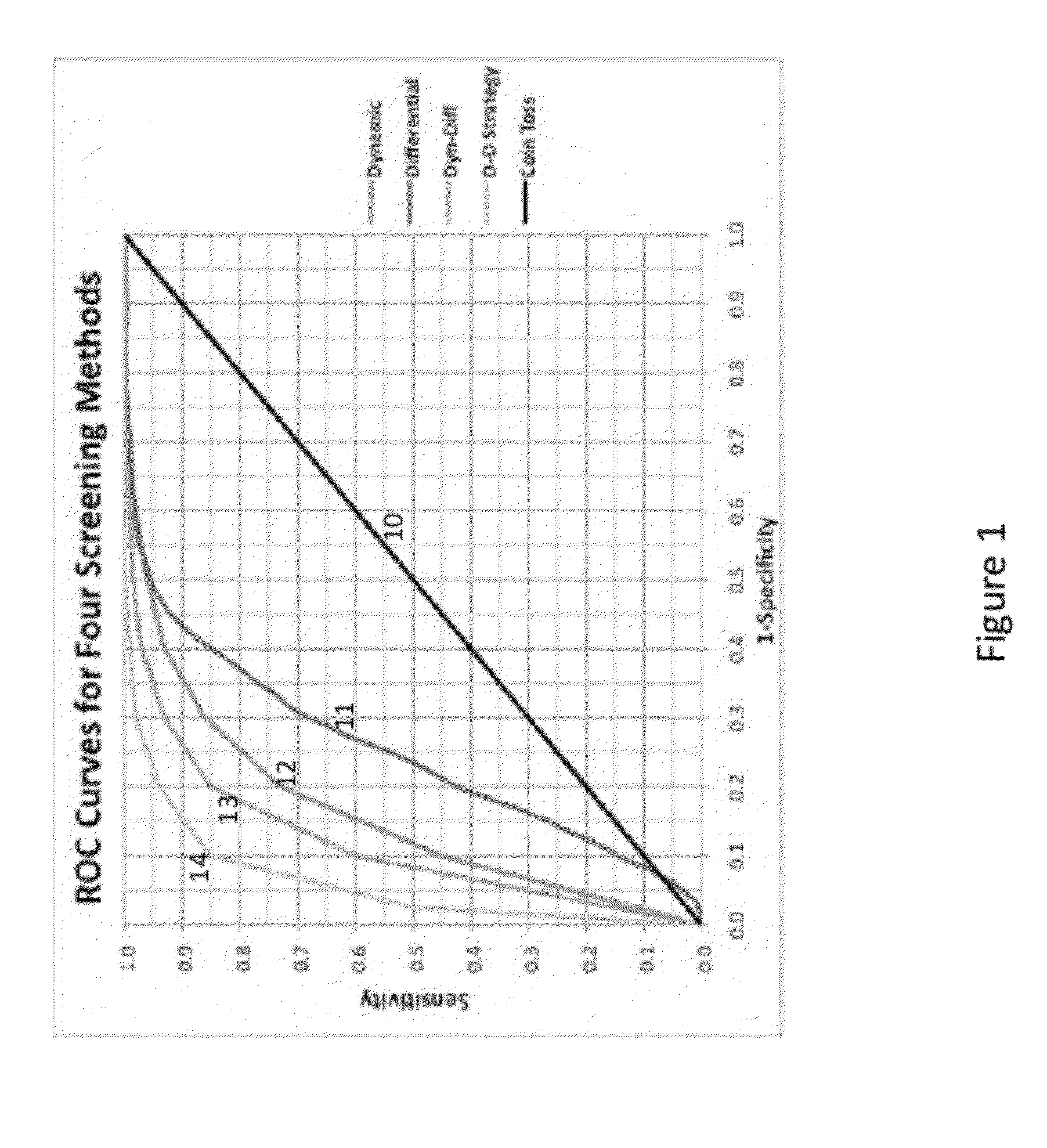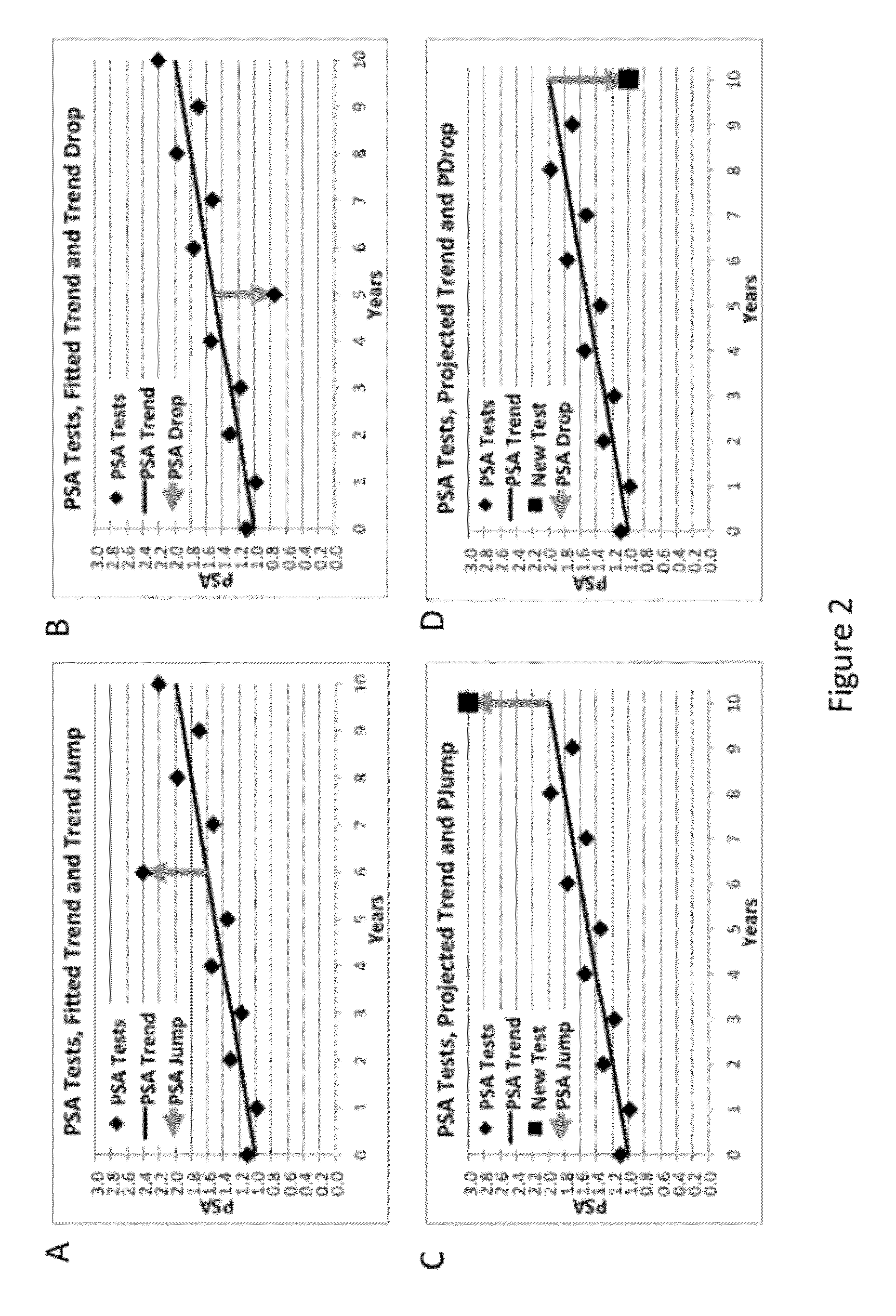Dynamic and Differential Analysis
a technology of differential analysis and dynamic analysis, applied in the field of dynamic and differential analysis, can solve the problems of inability to identify high gleason cancers, risk and side effects, excessive recurrence, etc., and achieve the effects of saving lives, reducing morbidity of unwarranted biopsies and overtreatment, and improving prostate cancer screening
- Summary
- Abstract
- Description
- Claims
- Application Information
AI Technical Summary
Benefits of technology
Problems solved by technology
Method used
Image
Examples
example 1
Dynamic Analysis
Materials and Methods
[0317]1,038 men from the Tyrol screening project and UCSF and CaPSURE databases were analyzed.
[0318]The sources of data were the:[0319]University of California at San Francisco (UCSF) surgery database. Please see: http: / / www.ucsfhealth.org / clinics / prostate_cancer_center / index.html[0320]Cancer of the Prostate Strategic Urologic Research Endeavor (CaPSURE) surgery database managed by UCSF. Please see: http: / / urology.ucsf.edu / capsure / overview.htm[0321]Innsbruck Medical University managed surgery database for the Tyrol region of Austria. Please see, for example: Bartsch et. al., Tyrol Prostate Cancer Demonstration Project: early detection, treatment, outcome, incidence and mortality; Urological Oncology, in BJU International, 101, 809-816, 2008.
[0322]670 men from the Tyrol screening project had no cancer detected by biopsy and at least 5 PSA tests over 4 years with no gap more than 2 years. These men are referred to as the full history no cancer grou...
example 2
Using FPSA to Distinguish Between Different Prostate Conditions
[0346]A simulator was built of a large population of men based on the published evidence about the distribution of cancer, its static and dynamic characteristics, and the results of antibiotic and anti-inflammatory treatment.
[0347]Healthy prostate, cancer, BPH, prostatitis due to infection and prostatitis due to inflammation were distinguished using static, dynamic and / or differential analysis of FPSA and PSA (FPSA %, FPSAV %, and FPSAΔ%, respectively). FPSA and PSA values were measured using Beckman-Coulter Access Immunoassays, which are used for FDA approval for the use of FPSA and FPSA % for prostate cancer screening in conjunction with PSA. FPSA % at various time points were calculated as a ratio of FPSA and PSA. FPSAV and PSAV were calculated based on the slope of a fitted trend at the time of the last test as determined by Dynamic Analysis using a constant+exponential functional form. FPSAV % was calculated as a ra...
example 3
Dynamic Analysis
[0370]Estimated and Projected PSA Trends—FIG. 27 shows six calibrated and adjusted PSA test results for an example subject over the last five years. A total consistent exponential plus constant PSA trend (272) is estimated using iterative methods to eliminate inconsistent results from the estimation process. An exponential plus constant function is used because PSA from progressing cancer usually grows exponentially and a main interest lies in detecting progressing cancer. The estimated trend is projected into the future (273). Base PSA is estimated (270) as part of the trend estimation process. It is assumed that base PSA (PSAn) is constant or grows very slowly. The estimation process treats it as a constant and projects it into the future at the constant level (271). If cancer is progressing then the difference between total PSA and base PSA is an estimate of PSA from cancer (PSAc). It is used to estimate cancer PSA growth rate (PSAgr=PSAV / PSAc), an important varia...
PUM
 Login to View More
Login to View More Abstract
Description
Claims
Application Information
 Login to View More
Login to View More - R&D
- Intellectual Property
- Life Sciences
- Materials
- Tech Scout
- Unparalleled Data Quality
- Higher Quality Content
- 60% Fewer Hallucinations
Browse by: Latest US Patents, China's latest patents, Technical Efficacy Thesaurus, Application Domain, Technology Topic, Popular Technical Reports.
© 2025 PatSnap. All rights reserved.Legal|Privacy policy|Modern Slavery Act Transparency Statement|Sitemap|About US| Contact US: help@patsnap.com



